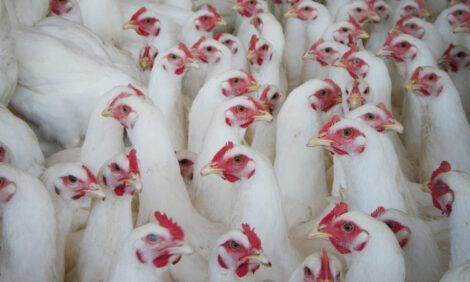



Animal Welfare - What is it Exactly?
A review of what broiler welfare means - both in theory and in practice - and who is responsible for the birds' well-being by Byron Stein, editor of 'The Drumstick' for the New South Wales Department of Primary Industries in Australia.The author explains that he was recently contacted by a grower who wanted to know the following: “What exactly is Animal Welfare? I need to know what it is and how to measure it if I want to make sure I am doing the right things by the birds and by the industry.”

It’s a good question and worth looking into. The aim of this article is to explore the meaning of animal welfare from the point of view of codes of practice, industry standards, legislation and science, and hopes to avoid the more emotive and ethical arguments advocated by others.
Animal welfare is becoming an increasingly important aspect of the business of producing poultry meat or eggs. This is in part being driven by:
- consumers who are demanding greater welfare standards
- supermarkets and retailers who typically respond to consumer trends, and
- animal activists who have their own agendas.
Irrespective of the reason, animal welfare should be viewed as equally important as any of the other elements of poultry production.
However, given poultry farming in all of its guises (barn or free-range) is inherently an intensive form of farming, what exactly is animal welfare and how can growers and/ or owners of commercial poultry businesses determine what the boundaries of animal welfare are?
The above question is further complicated in the broiler and turkey industries, because the carer of the birds is, in most cases, not the owner of the birds. So who is responsible for what and where will the lines be drawn in the event of an adverse animal welfare investigation and subsequent prosecution?
Animal Welfare versus Animal Cruelty
Before we explore this question, it is important to draw a distinction between animal welfare and animal cruelty.
This is because animal welfare has a vastly different meaning depending on who you talk to. For example, an animal activist is likely to have a significantly different view about animal welfare than a regular customer of the local chicken fast food shop down the road, or the farmer who just won farmer of the year for their husbandry skills.
Animal cruelty, on the other hand, is a much narrower issue and is more clearly defined and described in legislation.
Let’s Start with Animal Welfare
Essentially, animal welfare from a poultry perspective means that the basic needs of the birds are being met on a day to day basis. These needs are:
- Food and water are readily accessible
- Freedom to move, stand, turn around, stretch, sit and lie down
- Birds can see each other (visual contact with other members of the species)
- Shedding or housing which protects birds from the weather and which doesn’t harm or distress the birds
- Prevention of disease, injury and vice. If animals are diseased or injured, or there are outbreaks of feather pecking or cannibalism, they must be treated or managed as quickly as possible.
The above five basic needs have been paraphrased from the Model Code of Practice for the Welfare of Animals, Domestic Poultry (2001).
The RSPCA believes that an animal’s welfare should be considered in terms of 'Five Freedoms', which give us the boundaries with which to assess animal welfare together with the steps and compromises necessary to safeguard and improve welfare within an effective livestock industry. The five freedoms are:
- Freedom from hunger and thirst: by ready access to fresh water and a diet to maintain full health and vigour.
- Freedom from discomfort: by providing an appropriate environment including shelter and a comfortable resting area.
- Freedom from pain, injury or disease: by prevention through rapid diagnosis and treatment.
- Freedom to express normal behaviour: by providing sufficient space, proper facilities and company of the animal’s own kind.
- Freedom from fear and distress: by ensuring conditions and treatment which avoid mental suffering.
In addition to the basic needs and the Five Freedoms, government and industry codes of practice and standards provide further detail and spell out guidelines which stipulate recommended maximum stocking densities, light duration and intensity, shed environment (humidity and temperature) and litter condition.
From the above, it can be seen that the five basic needs and the Five Freedoms mirror each other but with some notable differences. So which of the above guides, i.e. the basic needs of poultry versus the Five Freedoms, is enforceable?
The answer is neither. The above are guidelines and are not enforceable in their own right, however they may be used in evidence as part of an investigation and subsequent animal welfare prosecution.
What is Enforceable?
Essentially, in New South Wales, the basis of any prosecution will depend on offences relating to the Prevention of Cruelty to Animals Act 1979 (POCTA).
In seeking to prosecute a case, a regulatory agency such as the RSPCA will seek evidence that offences have been committed under POCTA. whilst codes of practice, industry standards and other guidelines are not strictly enforceable, they may be used as part of a brief of evidence to support a case against a grower or a processor.
On the other hand, if a grower and processor can demonstrate that they have abided by industry standards, codes of practice and other industry and government accepted guidelines, then this may be used as a defence against any prosecution.
What is Meant by Animal Cruelty?
Animal cruelty is defined by POCTA as instances where animals are unreasonably, unnecessarily or unjustifiably:
- beaten, kicked, killed, wounded, pinioned, mutilated, maimed, abused, tormented, tortured, terrified or infuriated
- over-loaded, over-worked, over-driven, over-ridden or over-used
- exposed to excessive heat or excessive cold, or
- inflicted with pain (suffering and distress)
According to the Act, a person in charge of the animal must also:
- exercise reasonable care, control or supervision of an animal to prevent the commission of an act of cruelty upon the animal
- where pain is being inflicted upon the animal, take such reasonable steps as are necessary to alleviate the pain, or
- where it is necessary for the animal to be provided with veterinary treatment, whether or not over a period of time, to provide it with that treatment.
The Act also defines aggravated cruelty as instances which result in:
- the death, deformity or serious disablement of the animal, or
- the animal being so severely injured, so diseased or in such a physical condition that it is cruel to keep it alive.
The Act also requires a person in charge of the animals to provide the animals with food, drink or shelter, unless an adequate reason exists not to do so, for example, just prior to pickup or if under veterinary instruction.
It is worth noting that the Act refers to the Model Code of Practice for the Welfare of Animals (Domestic Poultry), and states that compliance or failure to comply with this code of practice is admissible in evidence in any proceedings under the act or the regulations.
Animal Welfare Standards, Codes and Guidelines

The chicken meat industry has published comprehensive guides on animal welfare standards. These are outlined in the ‘National Animal Welfare Standards for the Chicken Meat Industry’. The standards are broken down into several sections for each part of the chicken meat production cycle.
Growers should familiarise themselves with the National Animal Welfare Standards for the Chicken Meat Industry – Manual for Meat Chicken Farming. A copy can be downloaded from the Australian Chicken Meat Federation (ACMF) web site at www.chicken.org.au and by following the links to 'Bird Health and Welfare' or type in 'National Animal Welfare Standards and Manuals for the Chicken Meat Industry' into your favourite internet search engine. Alternatively, ask your processor for a copy.
The standards are based on Model Codes of Practice for poultry production, the Australian Standards and Guidelines for the Welfare of Animals, international and national guidelines and scientific evidence.
Growers or Processors? Who is Responsible for the Welfare of the Birds?
Both growers and processors, as owners of the birds, have a responsibility for their welfare. The act clearly specifies that the person in charge of the birds includes both the processor as well as the grower.
Growers may rightly state that they do not control stocking densities, pick-ups or the target weights of the birds. How can they be held responsible for their welfare if processors do not pick them up early enough or do not pick up enough birds to ensure densities remain within the guidelines?
The author's advice to growers is to ensure that:
- They read, understand and comply with the National Animal Welfare Standards for the Chicken Meat Industry and the Model Codes of Practice for the Welfare of Animals (Domestic Poultry)
- They keep accurate records to demonstrate that they have complied with the Standards and Codes. The National Welfare Standards have templates growers can use for record keeping purposes.
- They communicate with their processor any concerns they may have about animal welfare, including stocking densities, lameness, leg deformities, excessive mortalities or any other issue related to the health and welfare of the birds
- They keep records of their communication with their processor. For this reason, concerns should be communicated in writing and held on file to ensure growers can provide evidence of the communication if required to do so.
Summary
Animal welfare means different things to different people.
So from a growers perspective, how can we figure out what are acceptable animal welfare practices, and when or if we need to alert someone if we have any concerns?
A good starting point would be for growers to become familiar with the National Animal Welfare Standards for the Chicken Meat Industry - Manual for Meat Chicken Farming. The Standards outline what the expectations of industry are, and provide tools and templates for growers to record and demonstrate that they are doing as much as they can to comply with their animal welfare obligations.
Finally, growers are strongly encouraged to communicate and record any issues or concerns they have with their processors. This ensures that the processor is able to provide appropriate advice or take appropriate action to address any welfare concerns. It also ensures that the grower is able to demonstrate their duty of care to the birds should an animal welfare audit or investigation be conducted on their property.
September 2013











